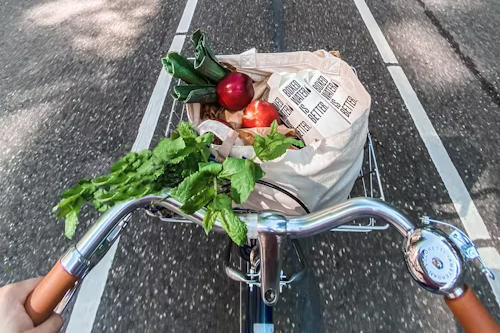What is the meaning of...?
Although there is a lot of information for consumers about food, this information is not always clear, or we don't know the meaning of it. How will we make better choices in terms of health and sustainability when there are so many concepts we do not understand? The following list includes common food concepts with a short explanation to help you in your food purchasing choices.
About nutrients:
- Macronutrient: major components of our diet, present in much larger quantities than the rest of the nutrients. They are proteins, carbohydrates and fats.
- Carbohydrates: These are sugar molecules. Along with proteins and fats, carbohydrates are one of three main nutrients found in foods and drinks. Your body breaks down carbohydrates into glucose. Glucose, or blood sugar, is the main source of energy for your body's cells, tissues, and organs.
- Dietary fibre: Fibre is mainly a carbohydrate made up of the indigestible parts or compounds of plants, which pass relatively unchanged through our stomach and intestines. The main role of fibre is to keep the digestive system healthy.
- Protein: Proteins are the basis of body structures, such as skin and hair, and of other substances such as antibodies. They are made up of 'building blocks' called amino acids. Your body uses proteins for growing and repairing cells.
- Trans-fatty acids: Manufactured fats which are created during a certain food processing. They may be particularly dangerous for heart health and may pose a risk for certain cancers.
- Omega 3 fatty acids: Fats that perform important functions in your body and can be protective against cardiovascular diseases. The main ones are alpha-linolenic acid (ALA), eicosapentaenoic acid (EPA) and docosahexaenoic acid (DHA).
- Saturated fat: This is a type of dietary fat. It is one of the unhealthy fats, along with trans-fat. Eating a diet high in saturated fats is associated with raised levels of non-HDL (bad) cholesterol.
- Micronutrient: Components of our diet, present in much lower quantities than macronutrients but very important for our health too. These are vitamins and minerals.
- Vitamin: Vitamins are substances that our bodies need to develop and function normally. They include vitamins A, C, D, E, and K, choline, and the B vitamins (thiamine, riboflavin, niacin, pantothenic acid, biotin, vitamin B6, vitamin B12, and folate/folic acid)
- Mineral: Minerals in food are the elements present in food that are required by our body to develop and function properly. Those essential for health include calcium, phosphorus, potassium, sodium, chloride, magnesium, iron, zinc, iodine, chromium, copper, fluoride, molybdenum, manganese, and selenium.
Related to food and health:
- Cholesterol: Cholesterol is a type of fat present in the blood. Although we need cholesterol to help the brain, skin and other organs perform their respective functions, eating too much fat and cholesterol is harmful to our health. There is so-called “good” cholesterol, which is HDL-cholesterol, and “bad” cholesterol, which is LDL-cholesterol.
- Antioxidants or bioactive compounds: These are man-made or natural substances that may prevent or delay some types of cell damage, preventing diseases. They are found in many foods, including fruits and vegetables
- Polyphenols: This is a type of antioxidant substance found mainly in fruits and vegetables.
- Beta-carotene: This is a red pigment present in tomatoes, peppers, and other foods and also has antioxidant properties. It is also a precursor of vitamin A, that is, the body transforms it to produce vitamin A.
- Licopene: This is a red pigment present in tomatoes, watermelon, and other products, with important antioxidant properties.
- Ultra-processed food: These are packaged foods that have been through many changes from their original state. They generally contain additives and preservatives, and they are usually high in unhealthy substances such as sugar, salt and unhealthy fats. Diets high in ultra-processed foods have been linked to cancer and heart disease, among other conditions.
- Fast food: Food that is prepared and served quickly with little consideration given to quality or significance.
- Food allergy and food intolerance: A true food allergy affects the immune system. Even small amounts of the offending food can trigger a range of symptoms, which can be severe or life-threatening. In contrast, a food intolerance often affects only the digestive system and causes less serious symptoms.
On the label:
- Free sugars: Free sugars include all added sugars in any form. This is all sugars naturally present in fruit and vegetable juices, purées and pastes and similar products in which the structure has been broken down; all sugars in drinks (except for dairy-based drinks); and lactose and galactose when they are added as ingredients.
- Light: Foods labelled as light do not have to meet any standards on their own but merely in comparison to the average of that type of food. It simply has to be better than the average products in terms of calories or fat, but it doesn´t mean that it is healthy.
- No sugar added: When manufacturers claim that a food has “no added sugar,” it means that no sugar or sugar-containing ingredients have been added. However, be careful! It may have sugar alcohol or artificial sweeteners. Products without added sugar may also contain sugar naturally present in the ingredients, such as fruit sugars.
- 'May contain traces of': This is a statement used to indicate that a product may be contaminated with a potential allergen through processing or manufacturing. Cross contamination during the processing stage can result in products containing 'traces' or small amounts of allergens. These trace allergens can be defined as allergens that are present in the food, but not as an intentional ingredient.
- Food additive: Chemicals added to foods to keep them fresh or to enhance their colour, flavour or texture. They may include food colourings, flavour enhancers or a range of preservatives.
- Portion and serving size: A “portion” is how much food you choose to eat at one time, whether in a restaurant, from a package, or in your own kitchen. A “serving” size is the amount of food listed on a product's nutritional facts. Sometimes, the portion size and serving size match; sometimes they do not.
- Nutriscore: This is a label designed to be placed on the front of food packaging so that consumers can easily see it and quickly assess the nutritional value of the food within a certain food category. It assigns food products to one of the five colour-coded letter grade classes (A, B, C, D, or E). Products that get an A score have the highest nutritional value — those that score an E have the lowest nutritional value.
- Expiration date and “best before date”: Expiration dates tell consumers the last day a product is safe to consume. Best before date on the other hand tells you that the food is no longer in its perfect shape from that date. It may just lose its freshness, taste, aroma or nutrients. It does not necessarily mean that the food is no longer safe to eat.
- Gluten free: Gluten is a protein present in cereals such as wheat, rye, barley or any of their derivatives. A gluten-free diet is the indicated treatment for celiac disease and gluten sensitivity. There is no evidence to show that following a gluten-free diet has any benefits in the general population.
- Bio, Eco, Organic: The terms eco, bio or organic denote a product with a mass of at least 95% organic ingredients.
- Organic food: Foods that have been grown and processed with natural methods, avoiding chemical additives and synthetic compounds. These practices are better for the environment, soil or biodiversity.
- Food allergens: Substances which can cause allergic reactions.
- Starch: This is a carbohydrate commonly found in nature and one of the primary sources of food energy for human beings. It is regularly eaten in the form of wheat, rice, potatoes, and other staple foods cultivated throughout the world. Alongside fibre and sugar, starch is one of the three main categories of carbohydrates.
- Nutrient content claim: This is a statement about of a nutrient found in a food.
- % Daily Value (%DV): The % Daily Value is the percentage of the Daily Value for each nutrient in a serving of the food. The Daily Values are reference amounts of nutrients to consume or not to exceed each day. When comparing two food products simply compare %DVs in each product to see which one is higher or lower in a particular nutrient.
Related with environmental sustainability and food:
- Sustainability: Sustainability is the ability to maintain or support a process over time. Sustainability is often broken into three core concepts: economic, environmental, and social.
- Biodiversity: The diversity of plants, animals and other organisms used for food, covering the genetic resources within species, between species and provided by ecosystems.
- Carbon footprint: An environmental indicator that represents the amount of greenhouse gases added to the atmosphere by a certain product, activity, company or country. It is expressed as CO2 equivalents, that are emitted directly or indirectly.
- Water footprint: An environmental indicator that measures the volume of fresh water needed to produce the goods and services demanded by society. It enables us to determine the magnitude of the impact generated by human activity and obtain objective data.
- Greenhouse gasses: These are gasses in the Earth's atmosphere that trap heat. They let sunlight pass through the atmosphere, but they prevent the heat that the sunlight brings from leaving the atmosphere. They are harmful for the environment.
- Clean label: Making a product using as few ingredients as possible and making sure those ingredients are items that consumers recognize and think of as wholesome ingredients that consumers might use at home.
- BPF-free: Products that are BPA-free do not contain any traces of Bisphenol-A. BPA is found in many plastic products, and unfortunately, it can leach into foods and beverages and then be absorbed into our bodies. As an estrogen-like compound, it may cause some health problems.
- Food traceability: This is the ability to follow the movement of a food product and its ingredients through all steps in the supply chain, both backward and forward. Traceability involves documenting and linking the production, processing, and distribution chain of food products and ingredients.







